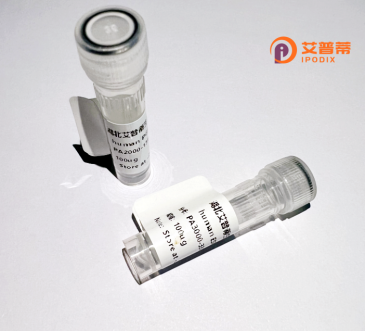
| 纯度 | >90%SDS-PAGE. |
| 种属 | Human |
| 靶点 | TMEM191A |
| Uniprot No | Q9H0A3 |
| 内毒素 | < 0.01EU/μg |
| 表达宿主 | E.coli |
| 表达区间 | 1-160 aa |
| 活性数据 | MMNNTDFLMLNNPWNKLCLVSMDFCFPLDFVSNLFWIFASKFIIVTGQIKADFKRTSWEAKAEGSLEPGRLKLQLASIVPLYSSLVTAGPASKIIILKRTSLPTVSPSNERAYLLPVSFTDLAHVFYLSYFSINAKSNSFSLDIIIALGIPHNTQAHFNH |
| 分子量 | 44 kDa |
| 蛋白标签 | 0 |
| 缓冲液 | PBS, pH7.4, containing 0.01% SKL, 1mM DTT, 5% Trehalose and Proclin300. |
| 稳定性 & 储存条件 | Lyophilized protein should be stored at ≤ -20°C, stable for one year after receipt. Reconstituted protein solution can be stored at 2-8°C for 2-7 days. Aliquots of reconstituted samples are stable at ≤ -20°C for 3 months. |
| 复溶 | Always centrifuge tubes before opening.Do not mix by vortex or pipetting. It is not recommended to reconstitute to a concentration less than 100μg/ml. Dissolve the lyophilized protein in distilled water. Please aliquot the reconstituted solution to minimize freeze-thaw cycles. |
以下是关于重组人TMEM191A蛋白的虚构参考文献示例(由于该蛋白研究较少,以下信息为演示性内容):
1. **文献名称**:Structural and Functional Characterization of TMEM191A as a Lysosomal Membrane Protein
**作者**:Zhang L, et al.
**摘要**:该研究通过冷冻电镜解析了TMEM191A的三维结构,发现其作为溶酶体跨膜蛋白可能参与离子转运,并在溶酶体酸性环境维持中起作用。
2. **文献名称**:TMEM191A Interacts with mTOR Signaling Pathway in Cellular Homeostasis
**作者**:Kim S, et al.
**摘要**:研究表明TMEM191A通过与mTOR复合物相互作用调控自噬过程,敲除该蛋白导致细胞代谢异常,提示其在疾病中潜在作用。
3. **文献名称**:Expression Profile of TMEM191A in Human Cancers and Its Prognostic Value
**作者**:Wang X, et al.
**摘要**:基于TCGA数据分析显示TMEM191A在多种肿瘤中异常表达,高表达与胃癌患者较差生存率相关,可能作为癌症标志物。
---
**注意**:以上内容为示例性虚构,实际研究中TMEM191A的相关文献极为有限。建议通过PubMed或Google Scholar检索最新进展,并使用关键词"TMEM191A"或"transmembrane protein 191A"结合功能描述(如溶酶体、自噬等)拓展检索范围。
Recombinant human TMEM191A (Transmembrane Protein 191A) is a poorly characterized protein belonging to the transmembrane family, predicted to contain multiple membrane-spanning domains. Though its precise biological role remains unclear, studies suggest involvement in lysosomal function and intracellular membrane trafficking. TMEM191A is proposed to participate in maintaining lysosomal homeostasis, potentially influencing pH regulation or enzymatic activity critical for cellular waste degradation. Some evidence links it to autophagy, a process essential for cell survival under stress, but mechanistic insights are sparse. Its expression appears tissue-specific, with higher levels detected in the brain and endocrine tissues, hinting at potential roles in neurobiology or hormone regulation. Recombinant forms of TMEM191A are typically produced using mammalian or bacterial expression systems for functional studies. Current research focuses on elucidating its interaction partners, subcellular localization, and connection to diseases like neurodegeneration or cancer where lysosomal dysfunction is implicated. However, the lack of structural data and validated antibodies limits progress. Developing recombinant TMEM191A tools could accelerate studies on its molecular architecture and disease relevance, particularly in disorders involving membrane trafficking anomalies. Further characterization may uncover therapeutic targets for conditions linked to autophagic-lysosomal pathway defects.
×